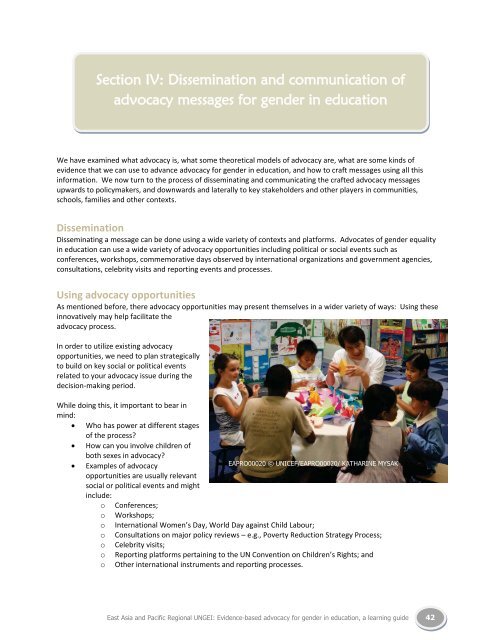Evidence-Based Advocacy - United Nations Girls' Education Initiative
Evidence-Based Advocacy - United Nations Girls' Education Initiative
Evidence-Based Advocacy - United Nations Girls' Education Initiative
You also want an ePaper? Increase the reach of your titles
YUMPU automatically turns print PDFs into web optimized ePapers that Google loves.
Section IV: Dissemination and communication of<br />
advocacy messages for gender in education<br />
We have examined what advocacy is, what some theoretical models of advocacy are, what are some kinds of<br />
evidence that we can use to advance advocacy for gender in education, and how to craft messages using all this<br />
information. We now turn to the process of disseminating and communicating the crafted advocacy messages<br />
upwards to policymakers, and downwards and laterally to key stakeholders and other players in communities,<br />
schools, families and other contexts.<br />
Dissemination<br />
Disseminating a message can be done using a wide variety of contexts and platforms. Advocates of gender equality<br />
in education can use a wide variety of advocacy opportunities including political or social events such as<br />
conferences, workshops, commemorative days observed by international organizations and government agencies,<br />
consultations, celebrity visits and reporting events and processes.<br />
Using advocacy opportunities<br />
As mentioned before, there advocacy opportunities may present themselves in a wider variety of ways: Using these<br />
innovatively may help facilitate the<br />
advocacy process.<br />
In order to utilize existing advocacy<br />
opportunities, we need to plan strategically<br />
to build on key social or political events<br />
related to your advocacy issue during the<br />
decision-making period.<br />
While doing this, it important to bear in<br />
mind:<br />
Who has power at different stages<br />
of the process?<br />
How can you involve children of<br />
both sexes in advocacy?<br />
Examples of advocacy<br />
opportunities are usually relevant<br />
social or political events and might<br />
include:<br />
EAPRO00020 © UNICEF/EAPRO00020/ KATHARINE MYSAK<br />
o Conferences;<br />
o Workshops;<br />
o International Women’s Day, World Day against Child Labour;<br />
o Consultations on major policy reviews – e.g., Poverty Reduction Strategy Process;<br />
o Celebrity visits;<br />
o Reporting platforms pertaining to the UN Convention on Children’s Rights; and<br />
o Other international instruments and reporting processes.<br />
East Asia and Pacific Regional UNGEI: <strong>Evidence</strong>-based advocacy for gender in education, a learning guide 42

















